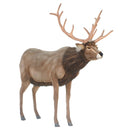Description
0186-DEER MALE are anatomically scaled to create the best reproduction of the life size stuffed animal and the most realistic stuffed animal in the industry. Head moves right and left.
The white-tail deer, also called Virginia deer, live from Southern Canada to South America.
This deer that has a white tail is bigger the further away from the equator it lives. They are a favorite target for hunters, but wolves, mountain lions, bears, jaguars, and coyotes also love to dine on them. White-tail deer are herbivores who often swim to get away from their predators. These animals that have been clocked running up to 30 miles per hour give birth typically to one fawn each year.
The coat of the White-tailed deer is a reddish-brown in the spring and summer and turns to a grey-brown throughout the fall and winter. The deer can be recognized by the characteristic white underside to its tail. It raises its tail when it is alarmed to warn the predator that it has been detected. An indication of a deer age is the length of the snout and the color of the coat, with older deer tending to have longer snouts and grayer coats. A population of white-tailed deer in New York is entirely white (except for areas like their noses and toes) - not albino - in color. White-tailed deer's horizontally slit pupils allow for good night vision and color vision during the day. Males regrow their antlers every year. Males without branching antlers are often termed "spikehorn", "spiked bucks", "spike bucks", or simply "spikes/spikers". The spikes can be quite long or very short. The length and branching of antlers are determined by nutrition, age, and genetics. Spiked bucks are different from "button bucks" or "nubbin' bucks", which are male fawns and are generally about 6 to 9 months of age during their first winter. They have skin-covered nobs on their heads. They can have bony protrusions up to a half inch in length, but that is very rare, and they are not the same as spikes. Males shed their antlers when all females have been bred, from late December to February.
White-tailed deer occur in most of southern Canada and all of the United States mainland except for a couple of western states. Their range covers the entire Mexico and Central America, reaching South America as far south as Peru and Bolivia. White-tailed deer live in various habitats, from big woods in northern Maine to Florida's hammock swamps and deep saw grass. They can also be found in brushy areas, open prairie, savanna woodlands, montane mixed oak and pine woodland communities, tropical and subtropical dry and moist broadleaf forests, adjacent wetland habitats, riparian corridors, rainforests, grasslands, plains, mountains, farmlands, plantations, pasturelands, suburban and urban areas.
Whitetails are herbivores and feed on twigs, bark, leaves, shrubs, the nuts and fruits of most vegetation, lichens, and other fungi. Plants such as yucca, huajillo brush, prickly pear cactus, ratama, comal, and a range of tough shrubs can be the mainstay of a whitetail's diet if it lives in a desert area. Though almost entirely herbivorous, White-tailed deer may opportunistically feed on nesting songbirds, field mice, and birds trapped in mist nets, if the need arises
- When White-tailed deer gather together and trample down snow in a particular area, this is called a "deer yard."
- White-tailed deer can jump vertically more than 2.5 meters (8.2 feet) and horizontally 9 meters (354 in), which is almost the length of a school bus.
- White-tailed deer swim well and can escape from predators through large streams and lakes.
- Only the males grow antlers, and they shed them each year.
- White-tailed deer are the shyest and most nervous of deer. When they are startled and run away, their tails wave from side to side.
- Deer can smell human odor on underbrush for days afterward. Bucks will stay away from areas that have been visited by humans for weeks afterward.
- Bucks usually lie on their right side when they go to sleep, and they face downwind, enabling them to employ their nose, ears, and eyes to detect danger in any direction.
- Product Dimension: 55.12"(L) X 14.17"(W) X 59.06"(H), Weight 25.90 lbs
HANSA CREATION, INC. Hansatronics is HANSA CREATION's hand-crafted collection of realistic plush animals. It takes great pride in each enchanting work of soft sculpture art, carefully designed to educate, fascinate, captivate and inspire creative play for collectors of all ages.
Artists create each HANSA animal from portraits of the creature in its natural habitat appropriately called Hansa Creation Portrait's in Nature. It is HANSA's uncompromising integrity in design and quality standards that has charmed collectors for generations and continues to mesmerize new collectors of all ages
Payment & Security
Your payment information is processed securely. We do not store credit card details nor have access to your credit card information.


